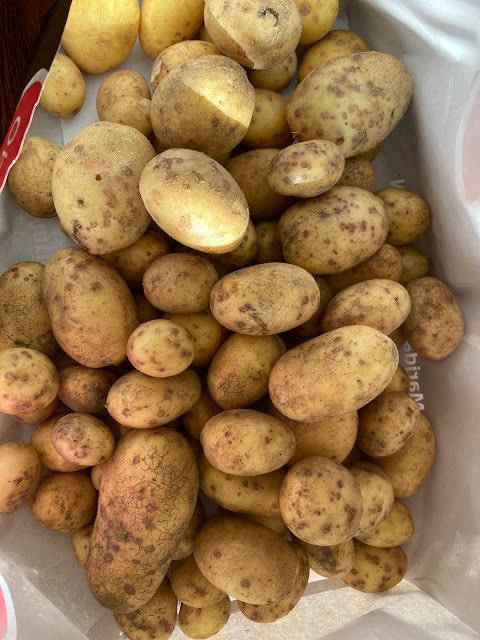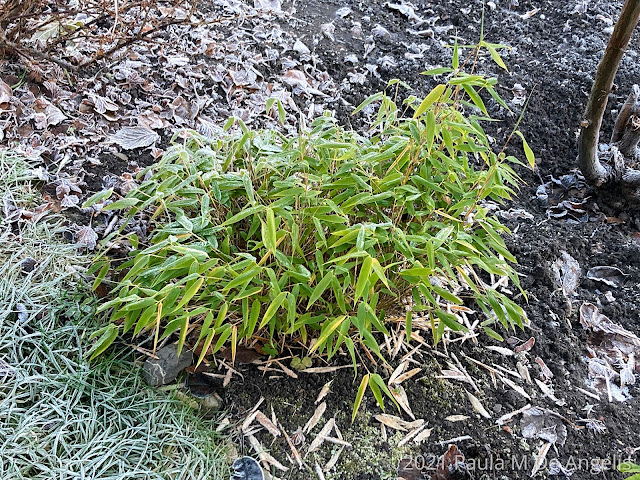June and July were busy months in the garden. I wasn't there as often as I would have liked due to vacation and family get-togethers (all enjoyable), but when I was there I was efficient. My project for this season was to rearrange/transplant many of the perennials from the main garden to other locations because they have grown so much in the past few years and need more space and increased air circulation. The hostas especially had grown quite big, but they were almost not visible because they were located at the back of the main garden behind some taller plants. Since I had to take up all of the strawberry plants this year to plant new ones, I decided to allocate some of the 'strawberry patch' space (two patches separated by the entrance path) to the hostas. When I took up the four hostas, they naturally split into three plants each, so that I was able to plant twelve new plants, six in each patch. They are doing quite well and are flowering. I also bought eighteen new strawberry plants and divided them between the two patches; I planted them below the hostas. They too are spreading out and doing well. I also transplanted an astilbe (false goat's beard) as well as a forsythia bush, and both are doing well. Online gardening sites don't recommend transplanting in the summertime, probably because temperatures are too warm. They suggest the autumn for such activities, but here in Oslo the summer temperatures have hovered around 70 degrees Fahrenheit. That is an optimal temperature to do transplanting; warm enough without being stifling hot for the plants. I water well before and after transplanting and for at least a week following transplanting. We've also had quite a bit of rain during early August, so that helped the plants to adapt and thrive in their new locations.
The crane's bill plant had also become quite large and was starting to crowd the nearby Phlox and peony plants in the main garden. So I took it up and divided it in half, planting both halves along the street fence. The other crane's bill plant was transplanted from its location at the entrance garden arch to a place further along the path fence. All of them are doing well.
I bought two new Phlox plants, a new astilbe, and a new coral bell plant--all perennials--and filled in the empty spaces with them. I really like Phlox plants; they come in many colors and have a lovely mild fragrance that you can smell when you get near them. I divided the summer aster plant in two and planted both in the main garden where the hostas used to be. One of them is flowering and the other is on the verge of doing so.
Of six pumpkin plants, three have produced pumpkins of a good size. A fourth plant has just started to grow a pumpkin, but the growing season is winding down here, so I'm not sure how big this pumpkin will be. It was a banner year for raspberries, gooseberries, black currants and red currants. Ditto for the zucchini plants--how many zucchinis they produce--it's amazing! The cucumber plants have given us some nice-sized cucumbers, and the tomato plants are loaded with ripening tomatoes. My string bean plants did not do very well and I'm not sure why. Likewise my gladiolas; some have flowered, most have not. Those that have bloomed have 'faded-looking' flowers, white at the edges. Strange. I've never seen that before. I googled it and the online info said that the corms could be too old. Or that thrips may be a problem (but I haven't seen any sign of these bugs). My blackberry bush is not productive either, but it doesn't appear to be suffering from any infestation. Only one of my two American blueberry bushes produced berries, which I don't understand and have to read more about. The Norwegian blueberry bushes both produced berries. Both yellow coneflower plants are big and beautiful; I love them. The rhododendron bush has also grown larger this year; it's been more or less the same size since we rescued and planted it in the garden back in 2016. The magnolia tree is starting to grow taller. But the true beauty in the garden this year was my wisteria--it is growing and expanding like crazy, and flowered early on. I cut it back a few weeks ago and it still keeps on keeping on. My pride and joy.
I have grown very fond of ground cover vegetation--pachysandra and hostas, for example. Pachysandra grows so well in my garden and is a hardy plant. It's also lovely to look at. Hostas likewise. The bumblebees love the hosta flowers, as do the honeybees. There were a lot of bumblebees in the garden this year and that was good to see. Some honeybees as well, but not as many as in previous years since the hives were removed from the garden. The bumblebees do a great job of pollinating plants, so there's no worries there.
My final project for this gardening season was to assemble and paint a chemically-impregnated pine wood bench that I bought from an online garden store. I painted it a forest green color and am happy with the results. Both the impregnation and the paint are designed to withstand all sorts of weather conditions, so I'm hoping that bears out. August is nearly at an end, so it's just to enjoy the rest of it, which I plan to do now that most of the heavy garden work is done. Put my feet up and read a book!
Gardening season is winding down. Of course there will be a lot to do in the garden to prep it for the winter months, so I won't be out of work during the autumn months. I've cut down the old raspberry canes already because for some reason the new cane growth for each plant has been vigorous this year. I'm not the only one who has commented on that.
The beauty of gardening is that from one year to the next there is always something new and different to tackle, understand, accept, and work around. There's never a dull moment in the garden. There's always work to do, and when you sit down to relax, the sparrows fluttering around and spraying water here and there in the birdbath will entertain you, as will the jumbo jets of the garden (my pet name for bumblebees). Watching them land on and take off from flowers will make you smile. If I am in a bad mood before I enter my garden, I leave with a better mood, a grateful heart, and a smile on my face. Nature has a way of centering me and making me realize what is important here in this life. And what is important is not what society says is important, that is for certain.
I'll post some photos of my garden in my next post.






































